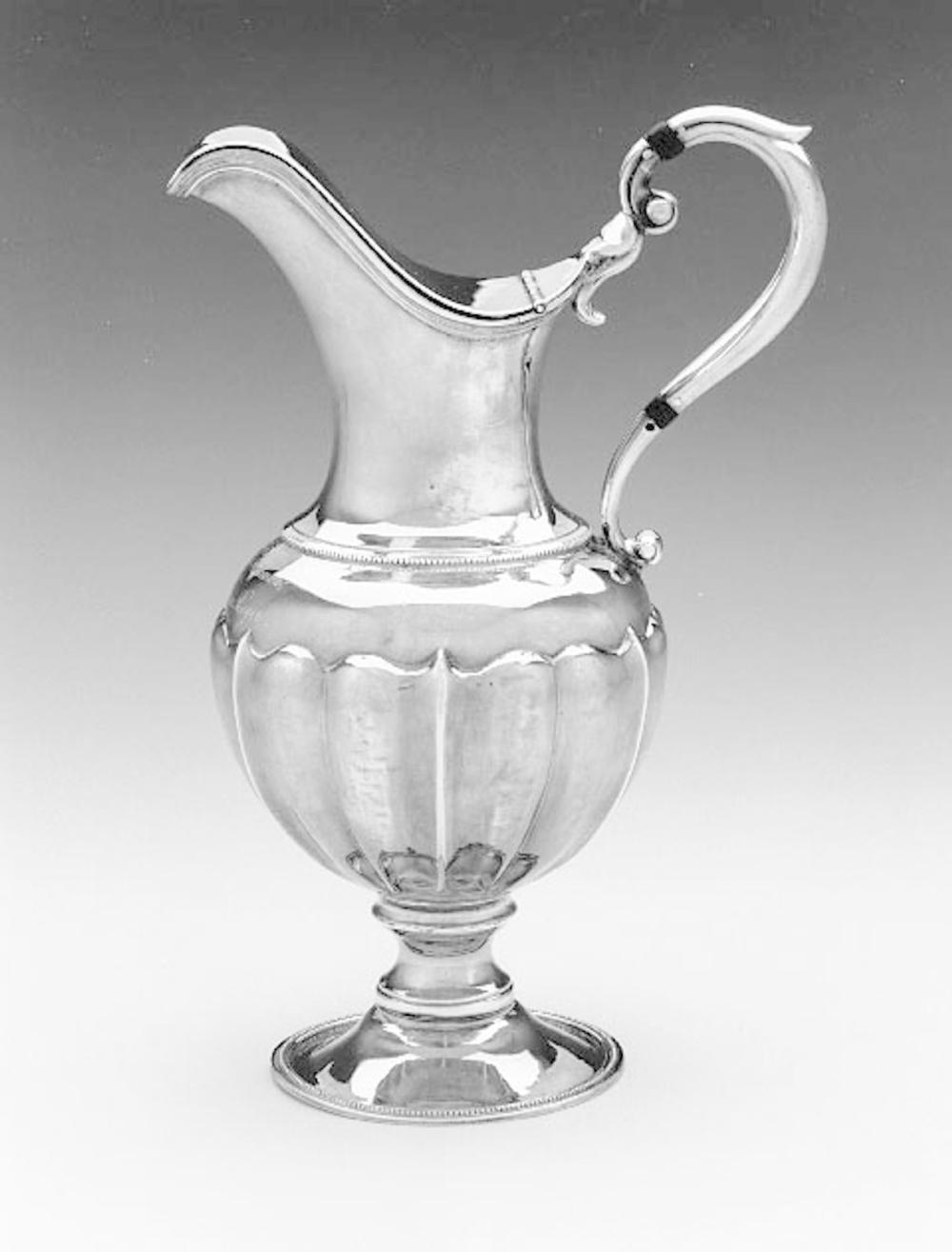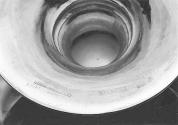Advanced Search
Ewer
Pitcher with hinged lid
Ewer
Retailed by: Lincoln & Foss (active 1847–1858)
Charles M. Foss (died in 1892)
Albert L. Lincoln (died in 1903)
Charles M. Foss (died in 1892)
Albert L. Lincoln (died in 1903)
about 1847–59
Object Place: Boston, Massachusetts
Medium/Technique
Silver
Dimensions
25 x 16.7 x 12 cm (9 13/16 x 6 9/16 x 4 3/4 in.)
Credit Line
Bequest of Maxim Karolik
Accession Number65.438
NOT ON VIEW
CollectionsAmericas
ClassificationsSilver hollowware
The pleasing curves and highly polished surface of this graceful ewer are accented by the sturdy ribs marking the double convex flutes that ring the body. Although the identity of the maker is unknown, the subtle lines and quality of construction indicate one of high ability.
Charles M. Foss and Albert L. Lincoln advertised their firm as “Importers and dealers in Rich Watches, Jewelry & Silver Ware.” Located at the corner of Court and Washington streets, the firm of Lincoln & Foss was within steps of Boston’s best jewelry houses, including Brackett & Crosby with Obadiah Rich (69 Washington); Palmer & Bachelders (91 Washington); Jones, Ball & Poor (123 Washington); Bigelow Brothers & Kennard (124 Washington); and Harris & Stanwood (253 Washington).
As with the retail mark of Lincoln & Reed, that of Lincoln & Foss appears on many pieces of hollowware along with place and quality stamps but no maker’s mark. As with the spoonholder bearing Vincent Laforme’s mark as well as the retail mark of Lincoln & Foss (cat. no. 223), other wares are marked both by Boston silversmiths Woodward & Grosjean (cat. no. 239) and by Lincoln & Foss. Since Boston retailers drew their silver flatware and hollowware stock from many sources in and outside Boston, including New York manufacturers, it is difficult to identify the maker of this ewer.
Lincoln & Foss was reorganized as Haddock, Lincoln & Foss in 1859, when longtime independent Boston silversmith Henry Haddock (cat. no. 202) joined the firm as senior partner. Haddock remained until 1868, when he retired from the silverware and jewelry business. That Haddock, whose credit was considered “good for all engagements,” chose to enter a partnership illustrates how large manufacturers had come to dominate the wholesale trade. Upon his retirement at age fifty-seven, Haddock engaged in the real estate business. At the time of his departure, the company was disbanded, and former partner Charles M. Foss joined the partnership of Samuel T. Crosby and Henry D. Morse, which was listed in the 1870 Boston directory as “Jewellers, Silversmiths, and Diamond Cutters. Also dealers of Rich Watches, Silver and Plated Wares.” By 1890 Crosby had retired, and Morse and Foss had become specialists in “Diamonds and other gems.”
By 1870 Albert L. Lincoln had become “reduced in means.” Credit reports noted that he was known as a “high-minded man . . . at one time with Haddock, Lincoln & Foss . . . [but] now occupying part of a store and stocked by a friend on commission . . . and doing his own work at small expense and not asking much credit.” The report also noted that Lincoln’s wife was known to have money but was also prudent and thus “not likely to furnish him with funds.” By 1875 Lincoln had gone into bankruptcy.
This text has been adapted from "Silver of the Americas, 1600-2000," edited by Jeannine Falino and Gerald W.R. Ward, published in 2008 by the MFA. Complete references can be found in that publication.
Charles M. Foss and Albert L. Lincoln advertised their firm as “Importers and dealers in Rich Watches, Jewelry & Silver Ware.” Located at the corner of Court and Washington streets, the firm of Lincoln & Foss was within steps of Boston’s best jewelry houses, including Brackett & Crosby with Obadiah Rich (69 Washington); Palmer & Bachelders (91 Washington); Jones, Ball & Poor (123 Washington); Bigelow Brothers & Kennard (124 Washington); and Harris & Stanwood (253 Washington).
As with the retail mark of Lincoln & Reed, that of Lincoln & Foss appears on many pieces of hollowware along with place and quality stamps but no maker’s mark. As with the spoonholder bearing Vincent Laforme’s mark as well as the retail mark of Lincoln & Foss (cat. no. 223), other wares are marked both by Boston silversmiths Woodward & Grosjean (cat. no. 239) and by Lincoln & Foss. Since Boston retailers drew their silver flatware and hollowware stock from many sources in and outside Boston, including New York manufacturers, it is difficult to identify the maker of this ewer.
Lincoln & Foss was reorganized as Haddock, Lincoln & Foss in 1859, when longtime independent Boston silversmith Henry Haddock (cat. no. 202) joined the firm as senior partner. Haddock remained until 1868, when he retired from the silverware and jewelry business. That Haddock, whose credit was considered “good for all engagements,” chose to enter a partnership illustrates how large manufacturers had come to dominate the wholesale trade. Upon his retirement at age fifty-seven, Haddock engaged in the real estate business. At the time of his departure, the company was disbanded, and former partner Charles M. Foss joined the partnership of Samuel T. Crosby and Henry D. Morse, which was listed in the 1870 Boston directory as “Jewellers, Silversmiths, and Diamond Cutters. Also dealers of Rich Watches, Silver and Plated Wares.” By 1890 Crosby had retired, and Morse and Foss had become specialists in “Diamonds and other gems.”
By 1870 Albert L. Lincoln had become “reduced in means.” Credit reports noted that he was known as a “high-minded man . . . at one time with Haddock, Lincoln & Foss . . . [but] now occupying part of a store and stocked by a friend on commission . . . and doing his own work at small expense and not asking much credit.” The report also noted that Lincoln’s wife was known to have money but was also prudent and thus “not likely to furnish him with funds.” By 1875 Lincoln had gone into bankruptcy.
This text has been adapted from "Silver of the Americas, 1600-2000," edited by Jeannine Falino and Gerald W.R. Ward, published in 2008 by the MFA. Complete references can be found in that publication.
DescriptionThe globular body of this small, spun, covered pitcher is decorated with ribbed pairs of wide convex flutes scalloped at the upper edge with ogee curves. Beading conceals the joint of the slender curved neck to the body. A flat cover with a five-part hinge follows the line of the applied molding at the rim and high curved spout with a cut tip for pouring. The hollow, cast, scrolled handle with inset wooden insulators curves above the rim and is affixed at the shoulder, the pins for the insets are loose. The body sits on a molded spool-form stem and splayed and domed foot edged with applied beading.
Marks
“LINCOLN & FOSS,” “BOSTON” and “FINE” within rectangles struck on foot, near edge. Several sets of five-digit numbers scratched in a modern hand, near marks.
Ada Mark * F4757
Ada Mark * F4757
Inscriptions"The Gift of / L. Rawlins Pickman / to / Martha Pickman Rogers" in script below the spout on the upper body.
ProvenanceThe pitcher was a gift from Love Rawlins Pickman (1786 – 1863) to her great-neice Martha Pickman Rogers (1829 – 1905). It may have been a wedding gift, for it was made about the time that Rogers m. John Amory Codman (1824 – 1886) in 1850. By descent to their daughter Martha Catherine Codman (1858 – 1948) and Maxim Karolik (1893 – 1963), m. 1928; made a bequest by Mr. Karolik.



